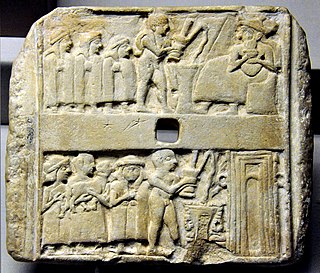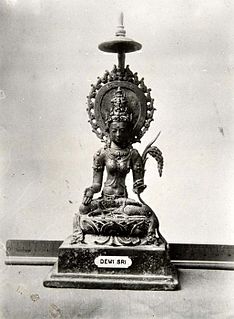Related Research Articles

In Norse mythology, Ymir, Aurgelmir, Brimir, or Bláinn is the ancestor of all jötnar. Ymir is attested in the Poetic Edda, compiled in the 13th century from earlier traditional material, in the Prose Edda, written by Snorri Sturluson in the 13th century, and in the poetry of skalds. Taken together, several stanzas from four poems collected in the Poetic Edda refer to Ymir as a primeval being who was born from venom that dripped from the icy rivers Élivágar and lived in the grassless void of Ginnungagap. Ymir birthed a male and female from the pits of his arms, and his legs together begat a six-headed being. The gods Odin, Vili and Vé fashioned the Earth from his flesh, from his blood the ocean, from his bones the mountains, from his hair the trees, from his brains the clouds, from his skull the heavens, and from his eyebrows the middle realm in which mankind lives, Midgard. In addition, one stanza relates that the dwarfs were given life by the gods from Ymir's flesh and blood.

The indigenous peoples of the Americas comprise numerous different cultures. Each has its own mythologies. Some are quite distinct, but certain themes are shared across the cultural boundaries.
Finnish mythology is a commonly applied description of the folklore of Finnish paganism, of which a modern revival is practiced by a small percentage of the Finnish people. It has many features shared with Estonian and other Finnic mythologies, but also shares some similarities with neighbouring Baltic, Slavic and, to a lesser extent, Norse mythologies.

In Mesopotamian mythology, Ereshkigal was the goddess of Kur, the land of the dead or underworld in Sumerian mythology. In later East Semitic myths, she was said to rule Irkalla alongside her husband Nergal. Sometimes her name is given as Irkalla, similar to the way the name Hades was used in Greek mythology for both the underworld and its ruler, and sometimes it is given as Ninkigal, lit. "Lady of the Great Earth".

Phaethon, also spelled as Phaëthon, was the son of the Oceanid Clymene and the sun god Helios in Greek mythology. His name was also used by the Ancient Greeks as an alternative name for the planet Jupiter, the motions and cycles of which were personified in poetry and myth.

Norse cosmology is the study of the cosmos (cosmology) as perceived by the North Germanic peoples. The topic encompasses concepts from Norse mythology, such as notions of time and space, cosmogony, personifications, anthropogeny, and eschatology. Like other aspects of Norse mythology, these concepts are primarily recorded in the Poetic Edda, a collection of poems compiled in the 13th century, and the Prose Edda, authored by Icelander Snorri Sturluson in the 13th century, who drew from earlier traditional sources. Together these sources depict an image of Nine Worlds around a cosmic tree, Yggdrasil.

The Inca religion was a group of beliefs and rites that were related to a mythological system evolving from pre-Inca times to Inca Empire. Faith in the Tawantinsuyu was manifested in every aspect of his life, work, festivities, ceremonies, etc. The population of the Tawantinsuyu didn't have an abstract concept of God and there was no word to define it. They were polytheists and there were local, regional and pan-regional divinities.
Estonian mythology is a complex of myths belonging to the Estonian folk heritage and literary mythology. Information about the pre-Christian and medieval Estonian mythology is scattered in historical chronicles, travellers' accounts and in ecclesiastical registers. Systematic recordings of Estonian folklore started in the 19th century. Pre-Christian Estonian deities included a sky-god known as Jumal or Taevataat in Estonian, corresponding to Jumala in Finnish, and Jumo in Mari.

Ekoi people, also known as Ejagham, are a Bantoid ethnic group in the extreme south of Nigeria and extending eastward into the southwest region of Cameroon. They speak the Ekoi language, the main Ekoid language. Other Ekoid languages are spoken by related groups, including the Etung, some groups in Ikom, some groups in Ogoja, Ufia and Yakö. The Ekoi have lived closely with the nearby Efik, Annang, Ibibio and Igbo people of southeastern Nigeria. The Ekoi are best known for their Ekpe headdresses and the Nsibidi text. They traditionally use Nsibidi ideograms, and are the group that originally created them.
The primary traditional Ekoi deities are Obassi Osaw, the sky god, and Obassi Nsi, the earth god, similar to the Efik. Ancestors and natural forces are also emphasized in Ekoi worship. Various Ekoi cults are devoted to the welfare of common activities, such as farming. Before the establishment of British colonial administration, the egbo was a prominent Ekoi secret society that had strong social regulatory functions as well as influence in religious matters. Members of the egbo used a form of ideographic writing called nsibidi, variations of which were formerly found among other ethnic groups in southeastern Nigeria.

Sumerian religion was the religion practiced and adhered to by the people of Sumer, the first literate civilization of ancient Mesopotamia. The Sumerians regarded their divinities as responsible for all matters pertaining to the natural and social orders.

The mythology of Indonesia is very diverse, the Indonesian people consisting of hundreds of ethnic groups, each with their own myths and legends that explain the origin of their people, the tales of their ancestors and the demons or deities in their belief systems. The tendency to syncretize by overlying older traditions with newer foreign ideas has occurred. For example, the older ancestral mythology might be merged with foreign mythology, such as Hindu, Islam, or Christian biblical mythology.

Wawacan Sulanjana is the Sundanese manuscript contains the Sundanese mythology. The title means "The Tale of Sulanjana", derived from the name of the hero Sulanjana as the protector of rice plant against the attack of Sapi Gumarang cow, Kalabuat and Budug Basu boars symbolizing rice pestilence. The Wawacan Sulanjana contains Sundanese local wisdom through reverence of rice cultivation in its tradition.
The Slavic creation myth is a cosmogonic myth in Slavic mythology that explains how the world was created, who created it, and what principles guide it. This myth, in its Christianized form, survived until the nineteenth and twentieth century in various parts of the Slavdom in chronicles or folklore. In the Slavic mythology there are three versions of this myth: the first version is the so-called earth-diver myth, which intertwines two main motifs: the dualistic motif – the cooperation of God and the Devil is required to create the world, and the oceanic motif – the pre-existence water, where the seed of the Earth comes from; the second version speaks about the origin of the universe and the world from the Cosmic Egg and the World Tree; the third one about creation from a dismemberment of a primordial being.
Gaunab is the personification of Death in Khoekhoen mythology. In some myths, he is also known as the embodiment of evil. He is often associated with Tsui’goab, and in some versions, is known to be his nemesis.
Huveane, also known as Huve or Huwe, is a trickster god and creator god in Pedi and Venda mythologies. In some versions of the myths, Huveane is also depicted as the first human on earth.
Libanza is a legendary figure in Boloki and Upoto mythologies. In Boloki mythology, Libanza is a heroic character who is depicted as the first man, while in Upoto mythology, Libanza is a supreme god worshipped for creating the universe.
Ngewo is the supreme creator god of the people of Mende from Sierra Leone.
Nzame is the supreme creator god featured in the mythologies of the Fang people of Equatorial Guinea, Gabon, and Cameroon. The name is used to refer to a trinity of deities, which included Nzame, Mebere and Nkwa and is also used in reference to Nzame, one of the members of this trinity.
References
- 1 2 3 4 5 Lynch, Patricia Ann; Roberts, Jeremy (2010). African Mythology, A to Z. Infobase Publishing. ISBN 978-1-4381-3133-7.
- ↑ "Ekoi | people". Encyclopedia Britannica. Retrieved 2021-02-21.
- 1 2 3 "Obassi Osaw and the First Fire". Oxford Reference. Retrieved 2021-02-21.
- 1 2 "OBASSI OSAW - the Ekoi God of Creation (African mythology)". Godchecker - Your Guide to the Gods. Retrieved 2021-02-21.
- ↑ "OBASSI NSI - the Ekoi God (African mythology)". Godchecker - Your Guide to the Gods. Retrieved 2021-02-21.